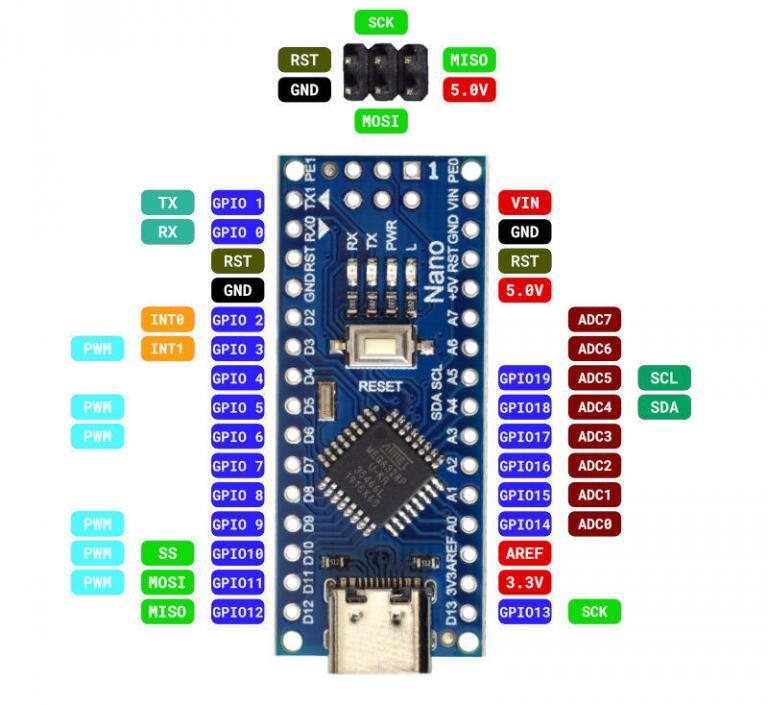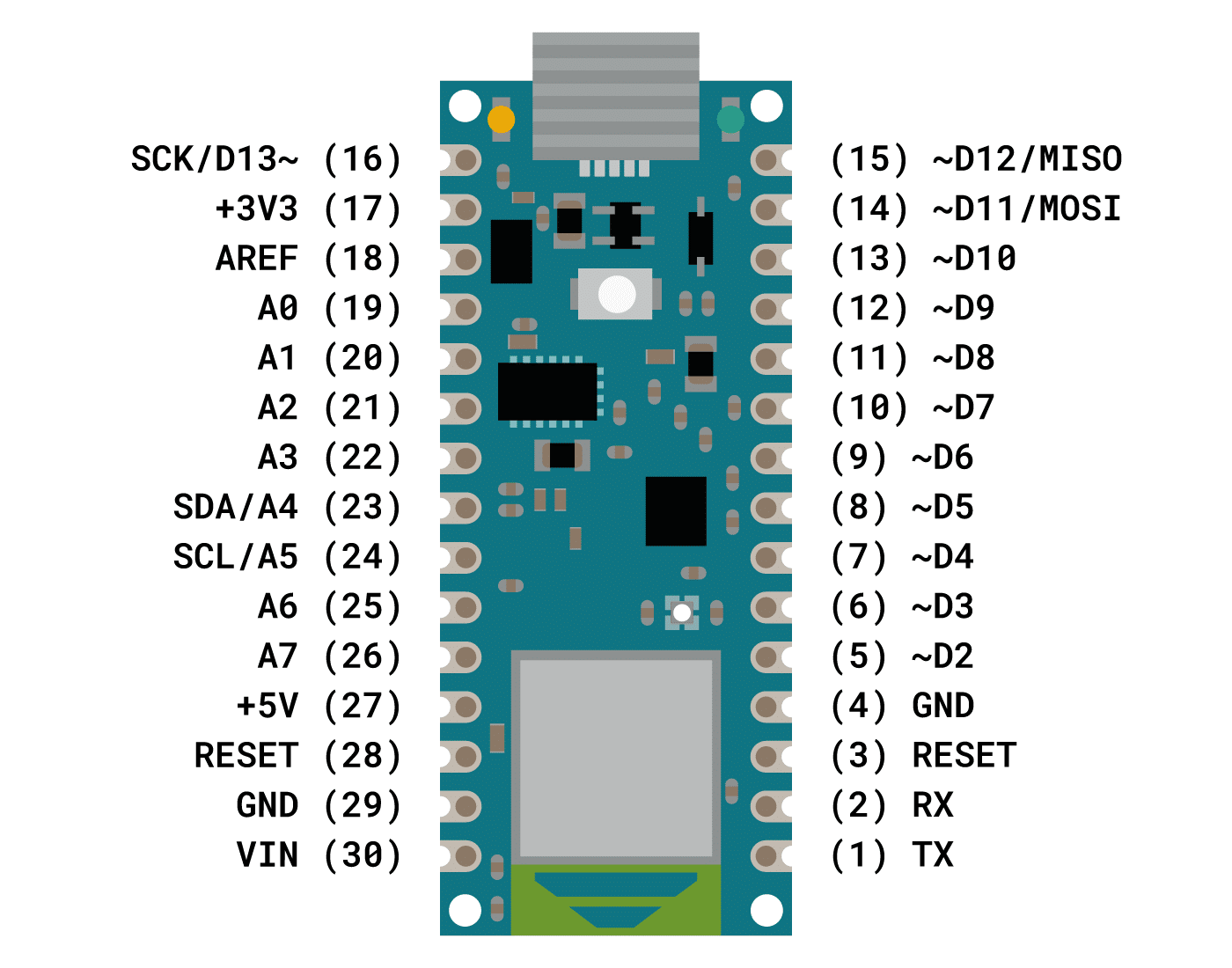

- #ARDUINO NANO PINOUT FOR FUNMOVE HOW TO#
- #ARDUINO NANO PINOUT FOR FUNMOVE SOFTWARE#
- #ARDUINO NANO PINOUT FOR FUNMOVE OFFLINE#
Please make your designs so that sensors and actuators are driven with 3.3V and work with 3.3V digital IO levels. The 3.3V, on the other hand, is always available and supports enough current to drive your sensors.

More specifically, the Keywish Nano with an upgraded micro USB plug.
#ARDUINO NANO PINOUT FOR FUNMOVE OFFLINE#
It is programmed using Arduino IDE which is an Integrated Development Environment that runs both offline and online.

No prior arrangements are required to run the board.
#ARDUINO NANO PINOUT FOR FUNMOVE SOFTWARE#
If you power the board from the VIN pin, you won't get any regulated 5V and therefore even if you do the solder bridge, nothing will come out of that 5V pin. The Arduino of choice for almost all of my projects these days is the Arduino Nano. All you need is a board, mini USB cable and Arduino IDE software installed on the computer. This means that if you have a design that takes 5V from that pin, it won't work immediately, as a precaution we put in place to draw your attention to the 3.3V compliance on digital and analog inputs.ĥV on that pin is available only when two conditions are met: you make a solder bridge on the two pads marked as VUSB and you power the NANO 33 IoT through the USB port. To avoid such risk with existing projects, where you should be able to pull out a Nano and replace it with the new Nano 33 IoT, we have the 5V pin on the header, positioned between RST and A7 that is not connected as default factory setting. Connecting higher voltage signals, like the 5V commonly used with the other Arduino boards, will damage the Arduino Nano 33 IoT. Spring til hovedindhold (tryk på Enter) Ny Webshop - Ris, ros eller udfordringer med siden kontakt tlf. Care must be taken when connecting sensors and actuators to assure that this limit of 3.3V is never exceeded. The Arduino Nano I/O Sensor Shield acts as an expansion board for the Arduino Nano and DFRduino Nano microcontrollers. The microcontroller on the Arduino Nano 33 IoT runs at 3.3V, which means that you must never apply more than 3.3V to its Digital and Analog pins. 5V is now an option for many modules and 3.3V is becoming the standard voltage for electronic ICs.Here you will find the technical specifications for the Arduino® Nano 33 IoT. The 3.3V, on the other hand, is always available and supports enough current to drive your sensors. The Arduino Nano can be programmed with the Arduino software. Hughes Rather than yet another project-based workbook, Arduino: A Technical Reference is a reference and handbook that thoroughly describes the electrical and performance aspects of an Arduino board and its software. It features a Wi-Fi / Bluetooth® module, a 6-axis IMU (Inertial Measurement Unit) with machine learning capabilities, a microphone and a built-in RGB. If you power the board from the VIN pin, you won't get any regulated 5V and therefore even if you do the solder bridge, nothing will come out of that 5V pin. The Arduino® Nano RP2040 Connect is a development board in Nano format, based on the RP2040 microcontroller.

The Arduino Nano Pinout’s small size can fit standard breadboards, making it the first choice for many applications. This means that if you have a design that takes 5V from that pin, it won't work immediately, as a precaution we put in place to draw your attention to the 3.3V compliance on digital and analog inputs.ĥV on that pin is available only when two conditions are met: you make a solder bridge on the two pads marked as VUSB and you power the Nano 33 BLE through the USB port. Eight analog Pins,14 digital pins, 6 Power Pins, and 2 Reset Pins. To avoid such risk with existing projects, where you should be able to pull out a Nano and replace it with the new Nano 33 BLE we have the 5V pin on the header, positioned between RST and A7 that is not connected as default factory setting. Connecting higher voltage signals, like the 5V commonly used with the other Arduino boards, will damage the Arduino Nano 33 BLE. Care must be taken when connecting sensors and actuators to assure that this limit of 3.3V is never exceeded. The microcontroller on the Arduino Nano 33 BLE runs at 3.3V, which means that you must never apply more than 3.3V to its Digital and Analog pins. Arduino Nano Every Pinout Arduino Every Pinout As shown in the above Arduino Nano Every pinout image, the board consists of 30 pins in total, 20 of which are digital I/O pins.
#ARDUINO NANO PINOUT FOR FUNMOVE HOW TO#
You will find a GPIO Map below this section that explains how to address the different pins. 2 p0 Pin(43, Pin.OUT) In the MicroPython port of the Nano 33 BLE board, the pinout is the same as the Nordic NRF52840 (the microcontroller). Here you will find the technical specifications for the Arduino® Nano 33 BLE. according to the Arduino pinout, we would actually need to use pin 43.


 0 kommentar(er)
0 kommentar(er)
